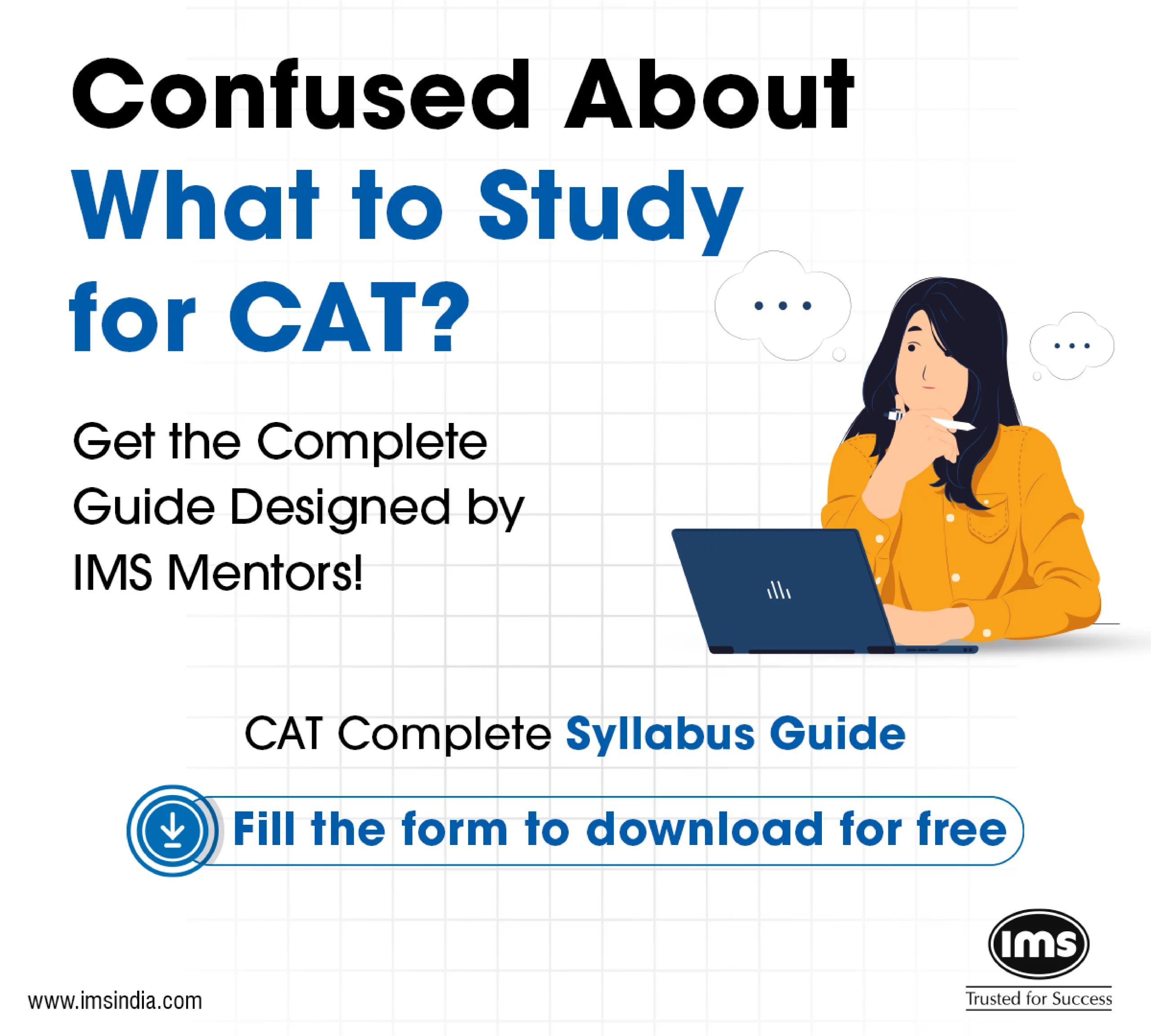CAT VARC Syllabus 2025: A Comprehensive Guide to Verbal Ability and Reading Comprehension
CAT VARC Syllabus 2025: The Verbal Ability and Reading Comprehension (VARC) section of the Common Admission Test (CAT) is an important part for anyone aiming to get into India’s top business schools. With CAT 2025 approaching, it is really helpful for future test-takers to understand the CAT VARC syllabus 2025, including its different parts and some smart strategies to prepare. Getting a good grip on these will help you perform better and improve your chances of making it into the college of your dreams.

Overview of CAT VARC Syllabus 2025
Total Questions: 24
Sectional Duration: 40 minutes
Marking Scheme:
-
- Correct Answer: +3 marks
- Incorrect Answer (MCQs): -1 mark
- No Negative Marking for Non-MCQs (TITA)
Read More: CAT Exam Date
The VARC section is divided into two main components:
- Reading Comprehension (RC): Approximately 66% of the section
- Verbal Ability (VA): Approximately 34% of the section
Reading Comprehension (RC)
Structure:
- Typically consists of 4 passages
- Each passage contains about 600 words.
- Followed by 4 questions per passage, totalling 16 questions
Types of Passages:
Argumentative: Most frequent; involves presenting and analyzing arguments
Analytical: Common; focuses on data interpretation and logical reasoning
Descriptive: Less frequent; provides detailed descriptions of events or concepts.
Narrative: Less frequent; tells a story or sequence of events
Abstract: Less frequent; deals with theoretical or philosophical ideas
Common Topics:
- Economics and Business
- Science and Technology
- Philosophy and Sociology
- History and Politics
- Literature and Art
Read More: CAT Syllabus 2025: Sections, Weightage, & Exam Pattern
Question Types:
Main Idea: Figuring out what the passage is mainly about.
Inference-Based: Making conclusions about things that aren’t directly said.
Specific Details: Answering questions about pieces of information.
Tone and Style: Understanding the author’s attitude and what their writing style is.
Application: Using the information that you have learned from the passage in new contexts.
Logical Structure: Looking at how the ideas are organized and how they flow from one to another.
Verbal Ability (VA)
Structure:
- Comprises 8 questions
- Includes both MCQs and Non-MCQs (TITA)
Question Types:
Jumbled Paragraphs: This task involves rearranging a set of sentences so that they logically flow as a coherent paragraph. Think of it as organizing mixed-up ideas into a structured sequence that actually makes sense.
Paragraph Summary: Here, you condense an entire paragraph into its core message. Basically, distil the main idea or thesis, capturing the essential point without the extra fluff.
Odd Sentence Out: This is about identifying which sentence doesn’t fit in the given paragraph. There’s always one that disrupts the logical flow or sits awkwardly with the rest—your work is to spot and remove it to maintain coherence.
Weightage:
- Para Jumbles: Approximately 3 questions
- Para Summary: Approximately 3 questions
- Odd Sentence Out: Approximately 2 questions
CAT VARC Syllabus 2025: Topic-Wise Weightage Summary
| Topic | Number of Questions | Approximate Weightage |
| Reading Comprehension | 16 | 66% |
| Para Jumbles | 3 | 12.5% |
| Para Summary | 3 | 12.5% |
| Odd Sentence Out | 2 | 8% |
Read More: CAT Exam Pattern
CAT VARC Syllabus 2025: Preparation Strategies
- Reading Comprehension:
Diverse Reading: Understanding an ample amount of text requires an individual to be equally immersed in different materials, such as everyday newspapers, academic journals, and even novels. These texts greatly influence the way an individual structures and correlates information, hence aiding in improving reading comprehension skills.
Regular Practice: Set aside a certain amount of time every day to answer Reading Comprehension passages, as regularly practicing these will help to improve reading speed and performance. Being able to fully understand the text and answer questions accurately within a given time is crucial and requires familiarity with the text.
Building Vocabulary: Understand colloquial terms while memorizing new words, as these contribute to widening one’s vocabulary. To make full sense of crucial pieces and passages, one’s vocabulary has to be advanced in order for the author’s intended meaning to be comprehended.
Pro Tip: Summarize Everything
After reading, summarize the article in your own words as if explaining it to a 12-year-old. If you read 100 articles but don’t summarize, it’s as good as reading none. Summarization builds comprehension, a core skill for VRC.
- Verbal Ability:
Sentence Rearrangement: To improve your logical thinking skills, encourage yourself to work on para jumble exercises. Be aware of different types of sentences and linking phrases in order to determine how the sentences are supposed to be arranged meaningfully in a paragraph.
Summarization: Shape the way you pull out key ideas from a paragraph, then condense to fundamentally deliver the core message in brief. Work on pinpointing the central idea and supporting ideas for quoting the text as you articulate the crucial parts in your own words.
Critical Analysis: Work on your critical thinking to discern out-of-context sentences in a paragraph that do not align with its ideas or flow. Work on judging how different sentences relate to and interconnect with each other in terms of their coherence and idea flow within a paragraph.
Overall Writing: Ensure you understand the basic rules of grammar, sentence construction and syntax so that you can create simple, straight-to-the-point, and flawless sentences. Strive to identify and resolve grammatical inaccuracies to enhance your writing quality.
Read More: Top MBA Colleges in India
Tips for Success
Time Management: In your preparation, equally split your attention between Reading Comprehension (RC) and Verbal Ability (VA) to ensure none of the sections are left out. In practice exercises and mock tests, continue to hone how you will divide time between each question and between parts of a section, in order to establish pacing that feels appropriate for the actual test.
VRC isn’t something you can crack in just a month or two by solving a few hundred reading comprehension questions. It really requires steady effort over time. Start reading now, mix up your sources, and make a habit of summarizing what you read every day. Those who get an early start will have a big advantage—so don’t wait around and let others gain ground while you’re slow to begin!
Mock Tests: In addition to your study plan, schedule regular full-length mock tests mimicking the real CAT test environment and mental status. Such exercises will help you get used to the test format and time, and can also assist you in deciding how well you understand each of the topics that are tested.
Analyze Mistakes: Allocate longer time slots to review wrong answers after every practice or mock test. The reasoning behind why you are doing it wrong is everything! Determine what concepts or kinds of questions were the most difficult for you, and make sure to address them (so you will more readily grasp and avoid making the same errors).
Stay Updated: Make it a habit to actively follow current affairs along with issues from innovative and social science literature. Such exposure
Read More: Top MBA Colleges in Hyderabad
CAT VARC Syllabus 2025: Conclusion
The Verbal Ability and Reading Comprehension (VARC) section of CAT 2025 calls for a well-managed effort for aspirants. Mastery of this syllabus depends on both the acquisition of reading comprehension skills and advanced verbal reasoning. In addition to the above, focusing on the basics, practicing with discipline, and having a broader grasp on the section components under ‘VARC’ for the section are equally important for those who wish to improve their sectional level performance. With a little bit of preparation, candidates are sure to be able to sit the exam with a lot more confidence, and this can only serve them well when they compete with others for attention from top management colleges.






